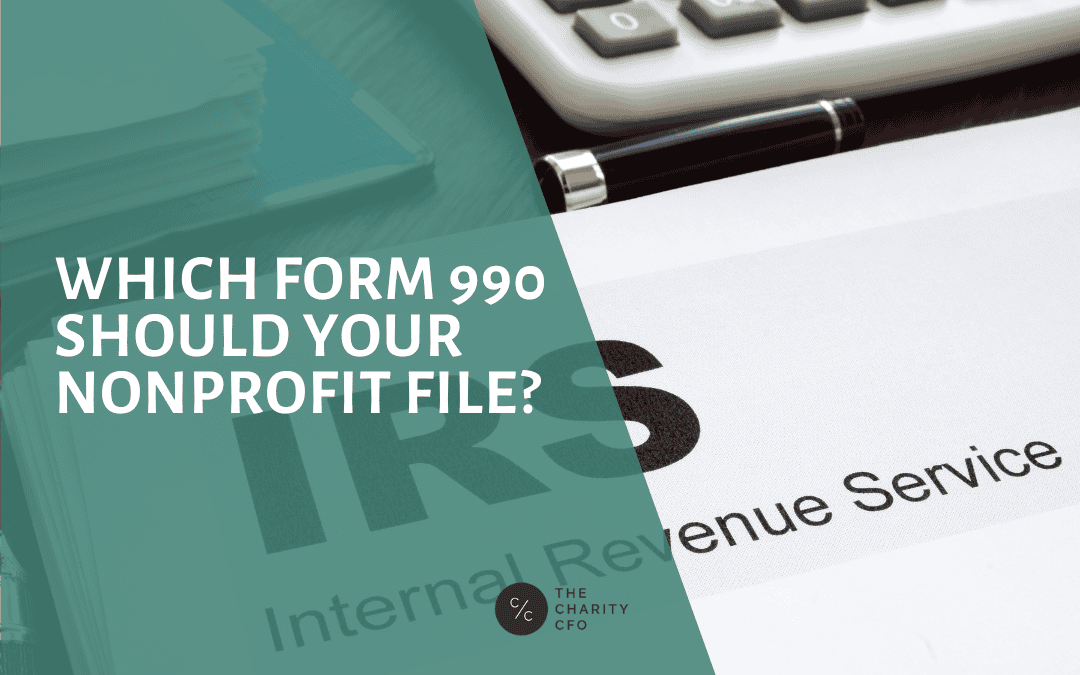Which IRS Form 990 Should Your Nonprofit File?

Every tax exempt nonprofit must file IRS Form 990 (Return of Organization Exempt from Income Tax) every year.
That’s right, your nonprofit needs to file an IRS return.
Your tax-exempt status has benefits, but it doesn’t exempt you from oversight. In fact, as a nonprofit organization, the expectations for transparency and accountability are higher than those for for-profit businesses.
Why do nonprofits need to file Form 990?
When you received your tax-exempt status as a 501(c)(3) organization, you committed to serving a specific purpose. And Form 990 is the IRS’s way to ensure that your organization follows through on that commitment.
It’s a tool for ensuring transparency, disclosure, and accountability to the public.
Form 990 is a public document available to anyone with a simple online search. Potential donors, existing donors, and watchdog agencies can see where your money comes from, how you’re spending it, and even how much you pay yourself or your executive team.
But, most importantly, you need to file Form 990 because it’s the law. If you don’t file for 3 consecutive years, you’ll automatically lose your tax-exempt status.
When is IRS Form 990 due?
You must file Form 990 for every year your nonprofit organization is operating.
Regardless of the version, your Form 990 is due on the 5th day of the 5th month following the end of the fiscal year.
That’s four and a half months from the end of your fiscal year. So if your fiscal year ended on December 31, your Form 990 is due on May 5.
Which 990 should I file?
There are four versions of Form 990 that may apply to most nonprofit organizations. Which one you file will depend on the type of organization and your size (annual revenue). We’ll look at each of the options below so you can determine which one is right for you.
PRO TIP: If you’re still waiting for your Form 1023 (application for tax exempt status) to be processed, you should still file Form 990 in anticipation of your application being approved.
1. Form 990-N
Simple e-postcard for nonprofits earning less than $50,000/year
Form 990-N is a virtual postcard which must be filed online. It simplifies the filing process for very small and startup nonprofits.
Only tax-exempt organizations with less than $50,000/year in annual revenue receipts are eligible to submit Form 990-N. However, there are a few exceptions for newer organizations.
Your organization can file the very simple 990-N if it:
- Exists for 1 year or less and is reporting less than $75,000 in revenue
- Exists for 1-3 years and is reporting less than $60,000 in revenue
- Exists for 3+ years and has reported less than an average of $50,000 in annual revenue over the most recent 3 years (including the current year)
The information included on Form 990-N is straightforward and standard to all versions of Form 990:
- Legal name and any trade names
- Name of the principal officer
- Whether or not the organization is still operating
- Federal Employee ID Number (EIN)
- Current address
Form 990-N is a breeze compared to the following two options, Form 990-EZ and Form 990.
It’s reasonable that a nonprofit could handle filing Form 990-N on its own. But if you have a CPA, it’s still a good idea to have them look at it rather than putting your tax-exempt status at risk.
2. Form 990-EZ
Short form for nonprofits earning $50,000-$200,000 a year
When you see the “EZ” don’t make the mistake of thinking it will be easy. The 990-EZ may be simpler than the full form, but it’s still a complex declaration of your organization’s finances.
Small to mid-sized nonprofits with annual revenue receipts between $50,000 and $200,000 or total assets valued at less than $500,000 can use this form.
The filing can be as short as four pages. Or as long as fifteen. It all depends on the complexity of your organization and funding sources.
Basic requirements for filing Form 990-EZ:
- Full accounting of income, expenses, and donors
- Balance sheet that matches the profit and loss information
- Overview of your Board of Directors and executive salaries
- Programming report: overview of functions, mission, and budget
- Declaration of any conflicts of interests related to the mission
- 5-year breakdown of financial records
- Information on donors who give more than $5,000 a year
If your organization falls into the $50,000-$200,000 range but must complete an annual audit for funding or GAAP purposes, it is wise to skip Form 990-EZ and head straight to the full form.
3. Full Form 990
For nonprofits earning over $200,000
If your nonprofit has gross annual revenue receipts greater than or equal to $200,000 OR a total asset valuation greater than or equal to $500,000, you’re required to file the full form 990.
And it’s a beast–the full Form 990 can be up to 50 pages long.
The full Form 990 asks for a lot of detail, but if you want the benefit of tax-exempt status, the IRS needs to know how you’re operating, where your money comes from, and exactly how you’re spending it.
Here is what you’ll find in Form 990:
- Twelve sections that report demographic and accounting information, similar to the info Form EZ, but in greater detail
- Information to classify expenses according to function (programming, administration, and fundraising) and detail what that money accomplished for each function)
- 16 “schedules” that provide supplemental information on funding sources, campaign activities, international activities, in-kind donations, etc. (your responses in the initial 12 sections determine which schedules you’re required to file)
NOTE: In most cases, the full form 990 is not a DIY IRS return. We recommend you always partner with a CPA familiar with nonprofit accounting to ensure compliance and proper reporting.
Additional 990 forms:
Almost all nonprofit organizations will use one of the three Form 990 variants above. But there are 2 other special-use 990 forms you should know:
Form 990-T: Calculate unrelated business income tax (UBIT)
As you may know, there is one exception to the “nonprofits don’t pay federal income tax” rule, and that’s for unrelated business activities.
If your nonprofit earns $1,000 or more in gross revenue from activities unrelated to our legally declared mission, you must report that revenue on form 990-T and pay taxes on it.
How do you know if your revenue is unrelated business income (UBI)? Revenue must meet these 3 requirements to be considered unrelated business income:
- It is a trade or business – meaning the activity produces income from selling goods or services.
- It is regularly carried on – the activities demonstrate frequency and continuity
- It is not substantially related to furthering the exempt purpose of the organization – they don’t contribute significantly or directly to accomplishing the organization’s declared mission
(SOURCE: Colorado Nonprofit Association)
As with all things IRS-related, there are some exceptions and exclusions you’ll want to check out. If you’re not sure if your income is business-related or not, check with your CPA or legal team.
Form 990-PF: for private foundations
Form 990-PF is used exclusively by private foundations as an alternative to the full form 990. It requires private foundations to disclose information on investments, endowments, earnings, and capital gains, and report any donations received from the public.
Like all form 990s, the 990-PF proves to the IRS that the foundation is operating according to its declared mission and distributing funds as required. It may also be the only public source of full grant lists for some smaller foundations that don’t issue annual reports to the public.
Want a stress-free 990 filing season?
When is the right time to start preparing for your next 990 filing? Every single day.
The easiest way to create a stress-free filing process is to keep your bookkeeping up to date and execute accounting best practices daily.
At The Charity CFO, we work with over 150 small to mid-sized nonprofits to help them automate and optimize their bookkeeping. And implement foolproof systems for tracking restricted funds, functional expenses, and more.
When you outsource your bookkeeping and accounting to us, we’ll ensure your books are always audit-ready. So when it’s time to file your 990, all you’ll need to do is review a few numbers and sign off on it.
We don’t file returns for non-clients because we’re dedicated to building long-term relationships with our nonprofit partners. If you want to see how done-for-you accounting can help you realize your vision for your organization, reach out for a free consultation today.







